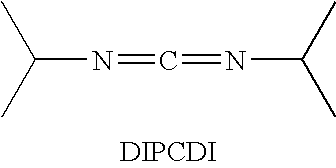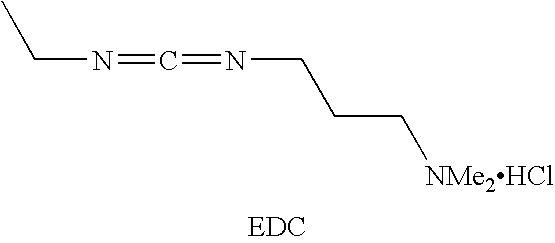Cyclic Antimicrobial Peptides
a peptide and antimicrobial technology, applied in the field of cyclic cationic peptides, to achieve the effects of non-hepatotoxic, non-hepatotoxic, and non-hepatotoxi
- Summary
- Abstract
- Description
- Claims
- Application Information
AI Technical Summary
Benefits of technology
Problems solved by technology
Method used
Image
Examples
example 1
[0106]Cyclisation of a 7 amino acid polylysine peptide was performed by dissolving 1 eq of protected peptide with 1 eq (eq=equivalent volume) of HATU in DMF (dimethylformamide) at 100 mg / ml. To increase the pH 2.5 eq of DIEA (diisopropylethylamine) were added and the progress of the reaction followed by HPLC. When complete the peptide was precipitated in water and washed in further water. The peptide was then dried and de-protected with hydrofluoric acid in order to produce the final cyclic peptide. Ion-exchange chromatography is then used to replace the hydrofluoric acid solvent with acetic acid prior to lyophilisation.
example 2
[0107]Cyclisation of a 7 amino acid polyarginine peptide was performed by combining 1 eq of protected peptide with 5 eq of NaHCO3 (sodium bicarbonate) and 2 eq of PyBOP dissolved in DMF at 28.5 mg / ml. The reaction was followed by TLC and when complete the peptide was precipitated in water and washed in further water. The peptide was then dried and de-protected with hydrofluoric acid in order to produce the final cyclic peptide. Ion-exchange chromatography is then used to replace the hydrofluoric acid solvent with acetic acid prior to lyophilisation.
example 3
[0108]Cyclisation of a 7 amino acid polyarginine peptide:
[0109]Solution 1: 57 mg of HBTU (Mwt=379.3, 0.15 mmole) or 57 mg of HATU (M=380.3, 0.15 mmole) and 60 μl of 0.92 mg / ml NMM (n-methylmorpholine, Mwt=101.2, 0.55 mmole) were dissolved in 2.86 ml of DMF.
[0110]Solution 2: 288 mg of H-[Arg(Pbf)]7—OH (Mwt=2877.6, 0.1 mmole) (7 amino acid polyarginine peptide) were dissolved in 0.71 ml of DMF.
[0111]Solution 2 was added dropwise to solution 1 over 30 min. The pH was checked by wet pH paper and must be 8.5-9. The reaction mixture was stirred at room temperature overnight*. The mixture was concentrated under vacuum. A solution of NaHCO3 (5%) was added. The precipitate of protected cyclopeptide was filtered and washed with water. 150-200 mg was obtained. The cleavage of Pbf groups were performed in TFA / Water (95 / 5, v / v) (10 ml for 1 g of protected cyclopeptide). The mixture was concentrated and IPE was added to precipitate the crude product. 100-110 mg of crude cycloArg was obtained.
[011...
PUM
| Property | Measurement | Unit |
|---|---|---|
| size | aaaaa | aaaaa |
| resistance | aaaaa | aaaaa |
| hydrophobic | aaaaa | aaaaa |
Abstract
Description
Claims
Application Information
 Login to View More
Login to View More - R&D
- Intellectual Property
- Life Sciences
- Materials
- Tech Scout
- Unparalleled Data Quality
- Higher Quality Content
- 60% Fewer Hallucinations
Browse by: Latest US Patents, China's latest patents, Technical Efficacy Thesaurus, Application Domain, Technology Topic, Popular Technical Reports.
© 2025 PatSnap. All rights reserved.Legal|Privacy policy|Modern Slavery Act Transparency Statement|Sitemap|About US| Contact US: help@patsnap.com



